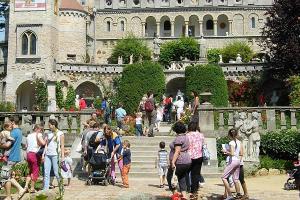We know just a few artists who built their own monument and museum in their lifetime, but Jenő Bory belongs to them.
The story of the castle started in 1912 when Jenő Bory bought the one acre land in Maria Valley near Székesfehérvár. It only had a little wine cellar and they spent their summer holidays there. He decided to build the castle after the project of the Church of Francis Ferdinand and the Sophia Home in Sarajevo failed due to World War I. He considered the castle his own work of art, a statue, rather than just a building. It had no plans, he just extended it year by year. This oversized home with its numerous decorations is a special example of Hungarian symbolic architecture. Even its layout is emblematical as its two centres, the Chapel and the Studio Gallery, symbolize two cardinal elements of Jenő Bory’s life. Several hundred statues which were made with the most diverse techniques can be seen in the castle. Paintings cover the walls, there are mosaics inside and outside of the building, glass paintings and fountains appear in the most unpredictable places.
The building wasn’t planned at a table but on the location. Bory was the architect, the project supervisor, the foreman and also the mason. He was building, developing and decorating this wonderful work of art since 1923 with the help of just a few helpers. From its dungeon up to the towers, the castle is 30 m high. It has seven towers, thirty rooms in different sizes including three studios, and there are statues, paintings, antiquities and works of art all over the castle. Heroes, kings and bards of Hungarian history, from Álmos to Sebestyén Tinódi Lantos, stand in the corridors of the Court of the Hundred Columns.




